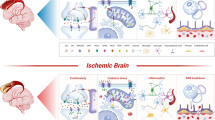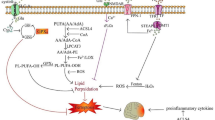Abstract
The microglia overactivation-induced neuroinflammation is a significant cause of the brain injury after intracerebral hemorrhage (ICH). Iron homeostasis is crucial for microglia activation, but the mechanism and causality still need further study. This study aimed to explore the roles and mechanism of the mitochondrial iron transporter SLC25A28 in microglia activation after ICH. Intrastriatal injection of autologous blood was used to establish ICH model, and the neuroinflammation, iron metabolism and brain injuries were assessed in wildtype or microglia-specific SLC25A28 knockout mice after ICH. Mitochondria iron levels and microglial function were determined in SLC25A28 overexpressed or deleted microglia. The extracellular acidification rate (ECAR), lactate production, and glycolytic enzyme levels were used to determine aerobic glycolysis. The results showed that ICH stimulated mitochondrial iron overload, and synchronously upregulated the SLC25A28 expression. In vitro, SLC25A28 overexpression increased mitochondrial iron levels in microglia. Interestingly, microglial SLC25A28 deficiency ameliorated neuroinflammation, brain edema, blood–brain barrier injury and ethological alterations in mice after ICH. Mechanically, SLC25A28 deficiency inhibited microglial activation by restricting the aerobic glycolysis. Moreover, zinc protoporphyrin could reduce SLC25A28 expression and mitigated brain injury. SLC25A28 plays crucial roles in mitochondrial iron homeostasis and microglia activation after ICH, and it might be a potential therapeutic target for ICH.








Similar content being viewed by others
Availability of Data and Materials
The data used or analyzed during the current study are available from the corresponding author on reasonable request.
References
Diseases, G.B.D., and C. Injuries. 2020. Global burden of 369 diseases and injuries in 204 countries and territories, 1990–2019: A systematic analysis for the Global Burden of Disease Study 2019. Lancet 396 (10258): 1204–1222.
Xue, M., and V.W. Yong. 2020. Neuroinflammation in intracerebral haemorrhage: Immunotherapies with potential for translation. Lancet Neurology 19 (12): 1023–1032.
Bai, Q., M. Xue, and V.W. Yong. 2020. Microglia and macrophage phenotypes in intracerebral haemorrhage injury: Therapeutic opportunities. Brain 143 (5): 1297–1314.
Urrutia, P.J., D.A. Borquez, and M.T. Nunez. 2021. Inflaming the brain with iron. Antioxidants (Basel) 10 (1).
Nnah, I.C. and M. Wessling-Resnick. 2018. Brain iron homeostasis: a focus on microglial iron. Pharmaceuticals (Basel) 11 (4).
Sun, Y., et al. 2022. Ferroptosis and iron metabolism after intracerebral hemorrhage. Cells 12 (1).
Nnah, I.C., C.H. Lee, and M. Wessling-Resnick. 2020. Iron potentiates microglial interleukin-1beta secretion induced by amyloid-beta. Journal of Neurochemistry 154 (2): 177–189.
Nakamura, K., et al. 2016. Activation of the NLRP3 inflammasome by cellular labile iron. Experimental Hematology 44 (2): 116–124.
Gan, Z.S., et al. 2017. Iron reduces M1 macrophage polarization in RAW264.7 macrophages associated with inhibition of STAT1. Mediators of inflammation 8570818.
Kenkhuis, B., et al. 2022. Iron accumulation induces oxidative stress, while depressing inflammatory polarization in human iPSC-derived microglia. Stem Cell Reports 17 (6): 1351–1365.
Ward, D.M., and S.M. Cloonan. 2019. Mitochondrial iron in human health and disease. Annual Review of Physiology 81: 453–482.
Muckenthaler, M.U., et al. 2017. A red carpet for iron metabolism. Cell 168 (3): 344–361.
Li, Z., et al. 2021. Formyl peptide receptor 1 signaling potentiates inflammatory brain injury. Science Translational Medicine 13 (605).
Wang, Y.C., et al. 2013. Toll-like receptor 4 antagonist attenuates intracerebral hemorrhage-induced brain injury. Stroke 44 (9): 2545–2552.
Minhas, P.S., et al. 2019. Macrophage de novo NAD(+) synthesis specifies immune function in aging and inflammation. Nature Immunology 20 (1): 50–63.
Perez de la Ossa, N., et al. 2010. Iron-related brain damage in patients with intracerebral hemorrhage. Stroke 41 (4): 810–813.
Sun, X.G., et al. 2022. Aerobic glycolysis induced by mTOR/HIF-1α promotes early brain injury after subarachnoid hemorrhage via activating M1 microglia. Translational Stroke Research.
Cloonan, S.M., et al. 2016. Mitochondrial iron chelation ameliorates cigarette smoke-induced bronchitis and emphysema in mice. Nature Medicine 22 (2): 163–174.
Kase, C.S., and D.F. Hanley. 2021. Intracerebral Hemorrhage: Advances in emergency care. Neurologic Clinics 39 (2): 405–418.
Wilkinson, D.A., et al. 2018. Injury mechanisms in acute intracerebral hemorrhage. Neuropharmacology 134 (Pt B): 240–248.
Bulters, D., et al. 2018. Haemoglobin scavenging in intracranial bleeding: Biology and clinical implications. Nature Reviews Neurology 14 (7): 416–432.
Cronin, S.J.F., et al. 2019. The role of iron regulation in immunometabolism and immune-related disease. Frontiers in Molecular Biosciences 6: 116.
Hu, X., et al. 2019. Iron-load exacerbates the severity of atherosclerosis via inducing inflammation and enhancing the glycolysis in macrophages. Journal of Cellular Physiology 234 (10): 18792–18800.
Paul, B.T., et al. 2017. Mitochondria and iron: Current questions. Expert Review of Hematology 10 (1): 65–79.
Seguin, A., et al. 2020. The mitochondrial metal transporters mitoferrin1 and mitoferrin2 are required for liver regeneration and cell proliferation in mice. Journal of Biological Chemistry 295 (32): 11002–11020.
Rouault, T.A. 2016. Mitochondrial iron overload: Causes and consequences. Current Opinion in Genetics & Development 38: 31–37.
Cunnane, S.C., et al. 2020. Brain energy rescue: An emerging therapeutic concept for neurodegenerative disorders of ageing. Nature Reviews Drug Discovery 19 (9): 609–633.
Orihuela, R., C.A. McPherson, and G.J. Harry. 2016. Microglial M1/M2 polarization and metabolic states. British Journal of Pharmacology 173 (4): 649–665.
Bernier, L.P., E.M. York, and B.A. MacVicar. 2020. Immunometabolism in the brain: How metabolism shapes microglial function. Trends in Neurosciences 43 (11): 854–869.
Ma, W.Y., et al. 2023. A breakdown of metabolic reprogramming in microglia induced by CKLF1 exacerbates immune tolerance in ischemic stroke. Journal of Neuroinflammation 20 (1): 97.
Urrutia, P.J., et al. 2017. Cell death induced by mitochondrial complex I inhibition is mediated by Iron Regulatory Protein 1. Biochimica et Biophysica Acta, Molecular Basis of Disease 1863 (9): 2202–2209.
Tavsan, Z., and H. Ayar Kayali. 2015. The variations of glycolysis and TCA cycle intermediate levels grown in iron and copper mediums of Trichoderma harzianum. Applied Biochemistry and Biotechnology 176 (1): 76–85.
Loboda, A., et al. 2016. Role of Nrf2/HO-1 system in development, oxidative stress response and diseases: An evolutionarily conserved mechanism. Cellular and Molecular Life Sciences 73 (17): 3221–3247.
Campbell, N.K., H.K. Fitzgerald, and A. Dunne. 2021. Regulation of inflammation by the antioxidant haem oxygenase 1. Nature Reviews Immunology 21 (7): 411–425.
Schipper, H.M., et al. 2019. The sinister face of heme oxygenase-1 in brain aging and disease. Progress in Neurobiology 172: 40–70.
Zhang, Z., et al. 2017. Distinct role of heme oxygenase-1 in early- and late-stage intracerebral hemorrhage in 12-month-old mice. Journal of Cerebral Blood Flow and Metabolism 37 (1): 25–38.
Fernandez-Mendivil, C., et al. 2021. Protective role of microglial HO-1 blockade in aging: Implication of iron metabolism. Redox Biology 38: 101789.
Acknowledgements
We thank the colleagues in the Pathology Department (Xijing Hospital, Fourth Military Medical University) for their technical assistance.
Funding
This study was supported by the National Nature Science Foundation of China (No. 81972342, No. 82170589), Science Basic Research Plan in Shaanxi Province (No. 2020JZ-29, No. 2022JM-536.), and National Key R&D Project of China (2022YFA0806501).
Author information
Authors and Affiliations
Contributions
Jing Ye, Changjun Gao, and Yu Gu designed the research and revised the manuscript. Ruili Han, Lei Liu, and Yuying Wang performed the experiments and drafted the manuscript. Ruolin Wu, Lele Jian and Ying Yang analysed the data. Yuanlin Zhao, Yuan Yuan and Lijun Zhang worked on the manuscript revision and technical assistance. All authors read and approved the final manuscript.
Corresponding authors
Ethics declarations
Ethics Approval and Consent to Participate
The animal study protocol was approved and supervised by the Animal Ethics Committee and the Animal Care and Use Committee of the Fourth Military Medical University (IACUC-20230048).
Consent for Publication
All the authors have read the manuscript and agreed to submit the paper to the journal.
Competing Interests
The authors declare no competing interests.
Additional information
Publisher's Note
Springer Nature remains neutral with regard to jurisdictional claims in published maps and institutional affiliations.
Supplementary Information
Below is the link to the electronic supplementary material.
Rights and permissions
Springer Nature or its licensor (e.g. a society or other partner) holds exclusive rights to this article under a publishing agreement with the author(s) or other rightsholder(s); author self-archiving of the accepted manuscript version of this article is solely governed by the terms of such publishing agreement and applicable law.
About this article
Cite this article
Han, R., Liu, L., Wang, Y. et al. Microglial SLC25A28 Deficiency Ameliorates the Brain Injury After Intracerebral Hemorrhage in Mice by Restricting Aerobic Glycolysis. Inflammation 47, 591–608 (2024). https://doi.org/10.1007/s10753-023-01931-1
Received:
Revised:
Accepted:
Published:
Issue Date:
DOI: https://doi.org/10.1007/s10753-023-01931-1




